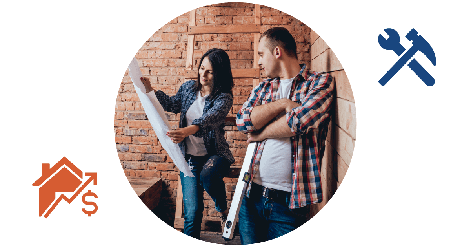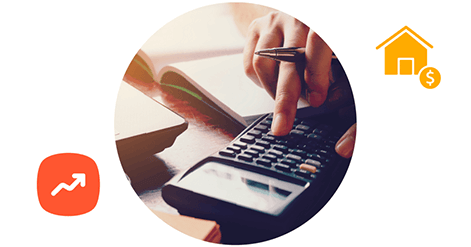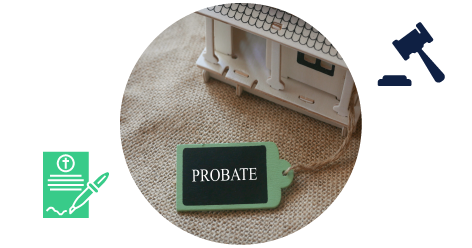Understanding and Calculating ARV in Real Estate: A Comprehensive Guide

ARV - three letters that can make or break your real estate investment.
It's essential for real estate profitability, making it a vital metric for investors, flippers, and lenders.
In this guide, we'll look at everything you need to know about ARV, including comparable properties, repair costs, holding costs, and local market trends.
Let's dive in…
- What is ARV in real estate?
- The step-by-step guide to calculating ARV
- Using ARV in real estate investment strategies
- Common mistakes to avoid in your ARV calculation
- Conclusion
What is ARV in real estate?
Definition of ARV (After Repair Value)
The After Repair Value (ARV) is the estimated market value of a property after it has undergone renovations, repairs, and improvements.
In other words, ARV is the price the property could sell for after it has been restored to its full potential.
To calculate ARV, investors look at several factors, such as the current property condition, the location, the size, and any repairs or necessary renovations.
Additionally, you should examine the sales price of comparable homes in the area that have recently been sold and pay particular attention to their condition and size.
Importance of ARV for investors, flippers, and lenders
ARV is crucial for real estate investors, flippers, and lenders. Here's why:
Helps with investment decision-making: For investors, understanding the ARV of a property is often one of the most important factors for making informed real estate investing decisions. It may be a profitable investment if the estimated ARV is higher than the purchase price plus renovation costs.
Helps with financing: Lenders use the ARV to determine how much they will lend to an investor. If the ARV is high, the lender may be more willing to offer a higher loan amount. This is because a property with a high ARV is more likely to generate a higher return on investment, which can help the lender mitigate their risk.
Helps with pricing: Flippers use the ARV to determine the selling price of the property. If they overestimate the ARV, they may price the property too high and struggle to find a buyer. However, if they underestimate the ARV, they may not make enough profit on the flip for it to be a worthwhile investment.
Key factors influencing ARV
Several factors can influence the ARV of a property. Here are some of the most important ones:
Location: Location is critical in determining a property's ARV, with desirable neighborhoods or good school districts having higher ARVs due to higher demand and amenities.
Quality school districts are a significant factor, as parents are often willing to pay a premium for top-rated schools. Proximity to public transportation or major highways, tourist destinations, or cultural attractions can also impact a property's ARV, although this impact can vary depending on the local real estate market.
Size: The size of a property is another critical factor in determining its ARV. In general, larger properties tend to have higher ARVs than smaller ones.
In particular, larger properties may have higher ARVs because they typically offer more living space, which can appeal to buyers and increase the property's value.
Condition: You can evaluate a property's condition by checking for structural damage, outdated features, and general wear and tear. Also, consider necessary repairs or renovations to bring the property to its full potential.
In some cases, the cost of repairs or renovations can be too significant to justify an investment in the property. However, the price may be manageable in other cases, and the potential ARV may make the property a worthwhile investment.
Renovations: Renovations can significantly impact a property's ARV, but the extent and type of renovation will determine the scope of the effect.
Some renovations, including kitchen and bathroom updates, are popular improvements that can make a property more functional, modern, attractive to buyers, and increase value. However, luxury features like a home theater or wine cellar may not necessarily increase a property's value.
The step-by-step guide to calculating ARV
Step 1: Research and select comparable properties
The market value of comparable properties plays a major role in determining a property's ARV.
According to a study by ATTOM Data Solutions, homes sold within 1 mile and in the same quarter as the subject property are the most accurate comparables, providing a median error rate of only 2.17%.
The study also found that using comparables within a 20% variance of the square footage of the subject property can result in a median error rate of only 3.87%.
To find the best comparables, industry professionals rely on various resources, including MLS, public records, and online real estate databases. Often, finding an easy way to locate and apply results from a comping tool can be challenging.
Luckily, PropertyRadar makes it incredibly easy to run comps with its built-in comping tool that scores comparable properties to help you identify your current property's value.
When evaluating the market value of comparable properties, you should also consider the time frame of recent sales. A NAR study found that 41% of real estate agents use comparable properties sold within the past three months to estimate a property's value.
Remember, inaccurate or inadequate comparables can lead to an inaccurate ARV, ultimately impacting the property's potential profitability.
Step 2: Evaluate the subject property's current condition
This inspection can include a visual inspection of the property's exterior and interior and a review of any available inspection reports or documents.
One of the primary factors that industry professionals look for is structural damage. Structural damage can be a significant expense to repair, and it can also impact the safety and stability of the property. This can include issues such as foundation problems, roof damage, and water damage.
Outdated features are another factor that you should look for when evaluating the subject property's condition.
Features such as old appliances, outdated plumbing or electrical systems, and dated finishes can make a property less desirable to buyers and impact the property's resale value.
Finally, consider any necessary repairs or renovations required to bring the property to its full potential.
These types of renovations can range from minor to major, and can include the following:
- Updates to the kitchen or bathroom.
- Replacing old flooring or carpeting.
- Making repairs to any damaged or worn-out features.
Step 3: Estimate repair and renovation costs
Determining the cost of repairs and renovations is an essential component of calculating the ARV of a property. Therefore, always thoroughly evaluate the property's condition and identify necessary repairs and renovations.
Industry professionals typically obtain quotes from contractors, review recent invoices for similar work, and use software tools that estimate repair costs based on the property's condition and location.
According to a report by HomeAdvisor, the average cost of remodeling a house in 2021 is $46,915, ranging from $19,800 to $74,400. The report also found that the most common remodeling projects include kitchen and bathroom renovations, with an average cost of $26,522 and $14,874, respectively.
Real estate investors and flippers may have an advantage in estimating repair costs, as they often have experience with property repairs and established relationships with contractors. However, you should note that repair costs can vary significantly depending on the project's size, location, and complexity.
When estimating repair costs, also consider commonly overlooked expenses. For example, permit costs, building code violations, and unforeseen repairs discovered during the renovation process can all add significant costs to a project.
For example, discovering asbestos or lead paint during renovations can require additional costs to remediate. Similarly, you should factor utility costs, insurance, and property taxes into the estimate to ensure an accurate estimate of the property's potential profitability.
Step 4: Factor in holding costs and other expenses
Holding Costs: Holding costs refer to the expenses associated with owning and maintaining a property, such as property taxes, insurance, and utilities.
Property taxes vary depending on the location and assessed value of the property, while insurance protects the property from damages and liability issues.
The cost of utilities varies depending on the size and location of the property. Therefore, accurately estimating these holding costs is critical in determining a property's ARV and potential profitability.
Financing Costs: Financing costs can include interest charges and origination fees associated with obtaining a loan for the property. Closing fees can include appraisal fees, title fees, and other fees related to the transfer of ownership.
In addition, you should always consider local and macro real estate market trends when estimating holding costs and other expenses is critical.
For example, holding costs may be lower in a strong seller's market because the property will likely sell quickly. However, in a weak buyer's market, the holding costs may be higher because the property is likely to sit on the market for a more extended period.
Step 5: Calculate the ARV using the gathered data
To calculate the ARV, you can choose from a few different methodologies to carry out your calculations.
The three primary methods for calculating the ARV are:
Cost approach: estimates the property's construction cost, including material and labor expenses. It is suitable for new construction and recently renovated properties and provides a baseline for the property's minimum value.
Sales comparison approach: evaluates the subject property's value by comparing it to recently sold properties of similar size, style, and condition in the same area. It helps determine the current market value of the property.
Income approach: determines the potential income the property could generate through rental income. It applies to investment properties and involves estimating the potential rental income and using a capitalization rate to determine the estimated value. This method helps evaluate the value of income-generating properties such as commercial and apartment buildings..
Using ARV in real estate investment strategies
Flipping properties
To maximize profit margins, house flippers typically aim to buy properties below the estimated ARV and complete repairs and renovations within a budget that allows for a profitable sale price.
This is where the 70% rule comes in.
The rule suggests that investors should aim to buy properties for no more than 70% of the estimated ARV, less the cost of repairs and renovations.
For example, if the estimated ARV of a property is $300,000, and the cost of repairs and renovations is estimated to be $50,000, the maximum purchase price under the 70% rule would be $185,000 (70% of $300,000, less $50,000). This calculation shows a profit margin of $65,000, assuming the property sells at the estimated ARV.
However, it's important to note that the 70% rule is not hard and fast, and the actual purchase price may vary depending on factors such as the local real estate market and the property's condition.
Buy-and-hold investments
Buy-and-hold investments are a popular strategy among real estate investors. This approach involves purchasing a property to hold it for an extended period, usually to generate rental income.
When evaluating potential rental properties, investors will typically assess the rental potential based on the property's ARV. This estimation allows them to determine the potential rental income and ensure that the property will generate a sufficient return on investment.
To maximize their return on investment, investors may also consider making strategic renovations or improvements to increase the property's rental value. For example, adding a bedroom or upgrading the kitchen can increase the rental value and attract higher-paying tenants.
It's also important to factor in holding costs such as property taxes, insurance, and maintenance when assessing the potential return on investment for buy-and-hold properties.
By accurately estimating the potential rental income and accounting for holding costs, you can determine the most profitable properties to add to your portfolio.
Lending and financing
Lenders use the ARV to decide how much financing they will provide for a particular property.
By considering the estimated value of the property after repairs and renovations are completed, lenders can determine the risk associated with the investment and make an informed decision about the amount of financing they are willing to provide.
This estimation allows them to determine the potential profitability of the investment and ensure that the loan amount is appropriate for the property's value.
LTV ratios are a critical component of real estate financing, as they dictate the funding available to borrowers.
By capping the amount of financing at a percentage of the ARV, lenders can minimize their risk exposure and ensure that the borrower is responsible for a significant portion of the investment.
Understanding LTV ratios is essential for securing favorable financing terms and maximizing the potential return on investment for borrowers.
Common mistakes to avoid in your ARV calculation
Overestimating the value of comparables
Using inaccurate or outdated comparable sales data can lead to an overestimation of the ARV, which can have negative financial consequences for investors and flippers.
According to a report by CoreLogic, the median error rate for home appraisals is 4.4%, indicating that using inaccurate comparables can lead to significant errors in estimating the ARV.
Underestimating repair and renovation costs
Underestimating the cost of repairs and renovations is another common mistake when calculating ARV.
As mentioned earlier, a report by HomeAdvisor found that the average cost of remodeling a house in 2021 is $46,915, ranging from $19,800 to $74,400.
Accurately estimate the cost of repairs and renovations to avoid a miscalculation of the potential profitability of a property and avoid financial losses.
Ignoring holding costs and other expenses
Holding costs and other expenses can significantly impact the overall profitability of a real estate investment.
According to a report by Zillow, holding costs can add up to 1-3% of the home's monthly value. These costs include property taxes, insurance, utilities, and financing costs.
Failing to account for these expenses when calculating ARV can lead to an inaccurate estimate of the property's potential profitability.
Failing to account for local market trends
Ignoring local market trends is another mistake that can impact the accuracy of ARV calculations.
The real estate market can be highly local, with different trends and dynamics in other regions and neighborhoods.
Failing to account for local market trends can result in inaccurate estimates of a property's ARV and potential profitability. For example, according to a report by Realtor.com, the median home price in the
United States increased by more than 13.9% in 2021 alone.
Given the market's volatility, always be sure to study and become familiar with market trends.
Conclusion
Understanding and accurately calculating the ARV can make or break an investment.
By following the steps covered earlier, you can gather the necessary data to estimate the potential resale value of a property after repairs and renovations are completed.
The ARV can help investors and flippers make informed decisions about purchasing, renovating, and selling properties, while also assisting lenders in determining loan amounts and financing options.
It's important to remember that there are potential pitfalls to be aware of when calculating the ARV, such as overestimating the value of comparables, underestimating repair costs, ignoring holding costs and other expenses, and failing to account for local market trends.
By avoiding these common mistakes, real estate professionals can maximize their profitability and achieve success in their investment strategies.
As you apply this knowledge to your real estate endeavors, remember to continually research and stay up-to-date with the latest trends and techniques in the industry.
With a solid understanding of ARV, you'll be better equipped to make informed decisions and maximize your return on investment.


